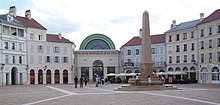Pier Carlo Bontempi
Pier Carlo Bontempi | |
|---|---|
 | |
| Born | 1954 (age 69–70) Fornovo di Taro, Italy |
| Nationality | Italian |
| Occupation | Architect |
| Awards | Driehaus Architecture Prize |
| Projects | Parma urban quarters, Place de Toscane and Quartier du Lac resort in Val d'Europe |
Pier Carlo Bontempi (born 1954) is an Italian architect.
He is a representative of New Urbanism and New Classical Architecture, with a particular emphasis on urban context and the continuity of architectural traditions.
Bontempi was awarded the 12th Driehaus Architecture Prize at a ceremony in the Murphy Auditorium of Chicago on March 29, 2014.[1][2]
Bontempi's office is located close to the town of Collecchio, Province of Parma in Emilia-Romagna, Italy.[3] His studio works on new traditional architecture include restoration, rebuilding and town planning, with award-winning urban old town developments in Parma, the Place de Toscane and the Quartier du Lac resort in Val d'Europe.
Career
Bontempi studied architecture at the University of Florence. During his career, he has subsequently taught at the Architecture Faculty of Florence, the École Spéciale d'Architecture in Paris, Syracuse University Abroad Center in Florence, the State Academy of Art and Design in Stuttgart, and the Prince of Wales’ Foundation for Building Community in London.[3]

He collaborates with the architects Massimo Gandini, Giuseppe Greci, Fabio Paoletti, Matteo Casola, Nicola Bergamaschi and Maria Cristina Celato. Bontempi won the architectural competition for the recovery plan of urban blocks in the historic center of Parma (1981-1987). In the year 1996, Bontempi received his second award at the international Marsham Street Urban Design Competition in London. He was also awarded the Prix Européen de la Reconstruction de la Ville in 1998, by the Fondation Philippe Rotthier pour l'Architecture de Bruxelles in Brussels.[3]
In 2000, Bontempi was the John Burgee Annual Lecturer at the Notre Dame School of Architecture, USA. In June 2001, the architect received a Charter Award at the Congress for the New Urbanism's annual conference ("CNU IX", New York). In 2002, he won the competition for the building of Place de Toscane in Val d'Europe, a project which has won the 2008 Palladio Award in Boston, USA.[3] In 2014, Bontempi was awarded the international Driehaus Architecture Prize for "a career of achievement in the art of traditional architecture". The prize is awarded to "a living architect whose work embodies the highest ideals of traditional and classical architecture in contemporary society, and creates a positive cultural, environmental and artistic impact".[4]
Further reading
- Rêve d'Italie, Pier Carlo Bontempi, 2004, AAM Editions, Archives d'architecture moderne, 63 pages[5]
- Pier Carlo Bontempi: Piazza Nuova ; Place de Toscane, Val d'Europe, Marne-la-Vallée, France, Léon Krier, Maurice Culot, 2008, AAM Editions, Archives d'architecture moderne, 109 pages[6]
- ArcChicago - Revenge of the Classicists: Driehaus Award to Pier Carlo Bontempi
References
- ^ "Architect Pier Carlo Bontempi to Receive the 2014 Richard H. Driehaus Prize". PRweb. Retrieved 29 March 2014.
- ^ "Pier Carlo Bontempi Named 2014 Driehaus Laureate". ArchDaily. Retrieved 30 March 2014.
- ^ a b c d "Pier Carlo Bontempi". INTBAU - International Network for Traditional Building, Architecture & Urbanism. Archived from the original on 29 March 2014. Retrieved 29 March 2014.
- ^ "Bontempi named the recipient of the 2014 Richard H. Driehaus Prize at the University of Notre Dame". Notre Dame School of Architecture. Archived from the original on 29 March 2014. Retrieved 29 March 2014.
- ^ Google Books
- ^ Google Books
External links
- Pier Carlo Bontempi website
- Bontempi at Bevan & Liberatos - February 12, 2014
- Interview with Bontempi at wttw - March 27, 2014

